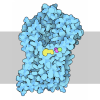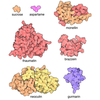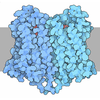+ Open data
Open data
- Basic information
Basic information
| Entry | Database: PDB / ID: 8uve | |||||||||||||||
|---|---|---|---|---|---|---|---|---|---|---|---|---|---|---|---|---|
| Title | Structure of NaDC3-Succinate complex in Coo-Ci conformation | |||||||||||||||
 Components Components | Na(+)/dicarboxylate cotransporter 3 | |||||||||||||||
 Keywords Keywords | TRANSPORT PROTEIN / Na(+)/dicarboxylate cotransporter(NaDC3) / Solute carries / Elevator type alternating access / membrane protein | |||||||||||||||
| Function / homology |  Function and homology information Function and homology informationdicarboxylic acid transmembrane transporter activity / dicarboxylic acid transport / high-affinity sodium:dicarboxylate symporter activity / sodium:dicarboxylate symporter activity / citrate transmembrane transporter activity / citrate transport / succinate transmembrane transport / Sodium-coupled sulphate, di- and tri-carboxylate transporters / alpha-ketoglutarate transmembrane transporter activity / succinate transmembrane transporter activity ...dicarboxylic acid transmembrane transporter activity / dicarboxylic acid transport / high-affinity sodium:dicarboxylate symporter activity / sodium:dicarboxylate symporter activity / citrate transmembrane transporter activity / citrate transport / succinate transmembrane transport / Sodium-coupled sulphate, di- and tri-carboxylate transporters / alpha-ketoglutarate transmembrane transporter activity / succinate transmembrane transporter activity / glutathione transmembrane transport / glutathione transmembrane transporter activity / lipid transport / transport across blood-brain barrier / basolateral plasma membrane / extracellular exosome / plasma membrane Similarity search - Function | |||||||||||||||
| Biological species |  Homo sapiens (human) Homo sapiens (human) | |||||||||||||||
| Method | ELECTRON MICROSCOPY / single particle reconstruction / cryo EM / Resolution: 2.6 Å | |||||||||||||||
 Authors Authors | Li, Y. / Wang, D.N. / Mindell, J.A. / Rice, W.J. / Song, J. / Mikusevic, V. / Marden, J.J. / Becerril, A. / Kuang, H. / Wang, B. | |||||||||||||||
| Funding support |  United States, 4items United States, 4items
| |||||||||||||||
 Citation Citation |  Journal: Nat Struct Mol Biol / Year: 2025 Journal: Nat Struct Mol Biol / Year: 2025Title: Substrate translocation and inhibition in human dicarboxylate transporter NaDC3. Authors: Yan Li / Jinmei Song / Vedrana Mikusevic / Jennifer J Marden / Alissa Becerril / Huihui Kuang / Bing Wang / William J Rice / Joseph A Mindell / Da-Neng Wang /  Abstract: The human high-affinity sodium-dicarboxylate cotransporter (NaDC3) imports various substrates into the cell as tricarboxylate acid cycle intermediates, lipid biosynthesis precursors and signaling ...The human high-affinity sodium-dicarboxylate cotransporter (NaDC3) imports various substrates into the cell as tricarboxylate acid cycle intermediates, lipid biosynthesis precursors and signaling molecules. Understanding the cellular signaling process and developing inhibitors require knowledge of the structural basis of the dicarboxylate specificity and inhibition mechanism of NaDC3. To this end, we determined the cryo-electron microscopy structures of NaDC3 in various dimers, revealing the protomer in three conformations: outward-open C, outward-occluded C and inward-open C. A dicarboxylate is first bound and recognized in C and how the substrate interacts with NaDC3 in C likely helps to further determine the substrate specificity. A phenylalanine from the scaffold domain interacts with the bound dicarboxylate in the C state and modulates the kinetic barrier to the transport domain movement. Structural comparison of an inhibitor-bound structure of NaDC3 to that of the sodium-dependent citrate transporter suggests ways for making an inhibitor that is specific for NaDC3. | |||||||||||||||
| History |
|
- Structure visualization
Structure visualization
| Structure viewer | Molecule:  Molmil Molmil Jmol/JSmol Jmol/JSmol |
|---|
- Downloads & links
Downloads & links
- Download
Download
| PDBx/mmCIF format |  8uve.cif.gz 8uve.cif.gz | 196.7 KB | Display |  PDBx/mmCIF format PDBx/mmCIF format |
|---|---|---|---|---|
| PDB format |  pdb8uve.ent.gz pdb8uve.ent.gz | 155.2 KB | Display |  PDB format PDB format |
| PDBx/mmJSON format |  8uve.json.gz 8uve.json.gz | Tree view |  PDBx/mmJSON format PDBx/mmJSON format | |
| Others |  Other downloads Other downloads |
-Validation report
| Summary document |  8uve_validation.pdf.gz 8uve_validation.pdf.gz | 1.7 MB | Display |  wwPDB validaton report wwPDB validaton report |
|---|---|---|---|---|
| Full document |  8uve_full_validation.pdf.gz 8uve_full_validation.pdf.gz | 1.7 MB | Display | |
| Data in XML |  8uve_validation.xml.gz 8uve_validation.xml.gz | 46.7 KB | Display | |
| Data in CIF |  8uve_validation.cif.gz 8uve_validation.cif.gz | 67.2 KB | Display | |
| Arichive directory |  https://data.pdbj.org/pub/pdb/validation_reports/uv/8uve https://data.pdbj.org/pub/pdb/validation_reports/uv/8uve ftp://data.pdbj.org/pub/pdb/validation_reports/uv/8uve ftp://data.pdbj.org/pub/pdb/validation_reports/uv/8uve | HTTPS FTP |
-Related structure data
| Related structure data |  42617MC  8uvbC  8uvcC  8uvdC  8uvfC  8uvgC  8uvhC  8uviC M: map data used to model this data C: citing same article ( |
|---|---|
| Similar structure data | Similarity search - Function & homology  F&H Search F&H Search |
- Links
Links
- Assembly
Assembly
| Deposited unit | 
|
|---|---|
| 1 |
|
- Components
Components
-Protein , 1 types, 2 molecules BA
| #1: Protein | Mass: 67236.023 Da / Num. of mol.: 2 Source method: isolated from a genetically manipulated source Details: Solute carrier family 13 member 3 / Source: (gene. exp.)  Homo sapiens (human) / Gene: SLC13A3 / Production host: Homo sapiens (human) / Gene: SLC13A3 / Production host:  Trichoplusia ni (cabbage looper) / References: UniProt: Q8WWT9 Trichoplusia ni (cabbage looper) / References: UniProt: Q8WWT9 |
|---|
-Non-polymers , 5 types, 22 molecules 








| #2: Chemical | | #3: Chemical | #4: Chemical | ChemComp-C14 / #5: Chemical | ChemComp-CLR / #6: Chemical | |
|---|
-Details
| Has ligand of interest | Y |
|---|---|
| Has protein modification | N |
-Experimental details
-Experiment
| Experiment | Method: ELECTRON MICROSCOPY |
|---|---|
| EM experiment | Aggregation state: PARTICLE / 3D reconstruction method: single particle reconstruction |
- Sample preparation
Sample preparation
| Component | Name: Dimer of NaDC3 in complex with succinate / Type: COMPLEX / Entity ID: #1 / Source: RECOMBINANT | |||||||||||||||||||||||||
|---|---|---|---|---|---|---|---|---|---|---|---|---|---|---|---|---|---|---|---|---|---|---|---|---|---|---|
| Molecular weight |
| |||||||||||||||||||||||||
| Source (natural) | Organism:  Homo sapiens (human) Homo sapiens (human) | |||||||||||||||||||||||||
| Source (recombinant) | Organism:  Trichoplusia ni (cabbage looper) Trichoplusia ni (cabbage looper) | |||||||||||||||||||||||||
| Buffer solution | pH: 7.5 | |||||||||||||||||||||||||
| Buffer component |
| |||||||||||||||||||||||||
| Specimen | Conc.: 6.2 mg/ml / Embedding applied: NO / Shadowing applied: NO / Staining applied: NO / Vitrification applied: YES | |||||||||||||||||||||||||
| Specimen support | Details: Hold 10s before glow discharge / Grid material: GOLD / Grid mesh size: 300 divisions/in. / Grid type: UltrAuFoil R1.2/1.3 | |||||||||||||||||||||||||
| Vitrification | Instrument: FEI VITROBOT MARK IV / Cryogen name: ETHANE / Humidity: 100 % / Chamber temperature: 281.15 K |
- Electron microscopy imaging
Electron microscopy imaging
| Experimental equipment |  Model: Titan Krios / Image courtesy: FEI Company |
|---|---|
| Microscopy | Model: FEI TITAN KRIOS |
| Electron gun | Electron source:  FIELD EMISSION GUN / Accelerating voltage: 300 kV / Illumination mode: FLOOD BEAM FIELD EMISSION GUN / Accelerating voltage: 300 kV / Illumination mode: FLOOD BEAM |
| Electron lens | Mode: BRIGHT FIELD / Nominal magnification: 105000 X / Calibrated magnification: 105000 X / Nominal defocus max: 1600 nm / Nominal defocus min: 1200 nm / Calibrated defocus min: 800 nm / Calibrated defocus max: 3000 nm / Cs: 2.7 mm / C2 aperture diameter: 70 µm / Alignment procedure: COMA FREE |
| Specimen holder | Cryogen: NITROGEN / Specimen holder model: FEI TITAN KRIOS AUTOGRID HOLDER / Temperature (max): 80 K / Temperature (min): 80 K / Residual tilt: 0.05 mradians |
| Image recording | Average exposure time: 1.8 sec. / Electron dose: 52.58 e/Å2 / Film or detector model: GATAN K3 BIOQUANTUM (6k x 4k) / Num. of grids imaged: 1 / Num. of real images: 5179 Details: 5179 untilted images were collected in super resolution mode at 40 frames per micrograph |
| EM imaging optics | Energyfilter name: GIF Bioquantum / Energyfilter slit width: 20 eV |
| Image scans | Sampling size: 5 µm / Width: 5760 / Height: 4092 |
- Processing
Processing
| EM software |
| ||||||||||||||||||||||||||||||||||||||||||||||||
|---|---|---|---|---|---|---|---|---|---|---|---|---|---|---|---|---|---|---|---|---|---|---|---|---|---|---|---|---|---|---|---|---|---|---|---|---|---|---|---|---|---|---|---|---|---|---|---|---|---|
| Image processing | Details: The micrographs with an overall resolution worse than 5 angstrom were excluded | ||||||||||||||||||||||||||||||||||||||||||||||||
| CTF correction | Details: CTF amplitude correction was performed after particle polishing Type: PHASE FLIPPING AND AMPLITUDE CORRECTION | ||||||||||||||||||||||||||||||||||||||||||||||||
| Particle selection | Num. of particles selected: 2932803 / Details: Particles were selected from 5040 untilted images | ||||||||||||||||||||||||||||||||||||||||||||||||
| Symmetry | Point symmetry: C1 (asymmetric) | ||||||||||||||||||||||||||||||||||||||||||||||||
| 3D reconstruction | Resolution: 2.6 Å / Resolution method: FSC 0.143 CUT-OFF / Num. of particles: 228347 / Algorithm: FOURIER SPACE / Num. of class averages: 1 / Symmetry type: POINT | ||||||||||||||||||||||||||||||||||||||||||||||||
| Atomic model building | B value: 68.84 / Protocol: OTHER / Space: REAL / Target criteria: cross-correlation coefficient Details: Initial local fitting was done using Chimera and then coot was used for ajustment. | ||||||||||||||||||||||||||||||||||||||||||||||||
| Atomic model building | Chain residue range: 1-602 / Details: The whole model was used as an initial model / Source name: AlphaFold / Type: in silico model |
 Movie
Movie Controller
Controller










 PDBj
PDBj










